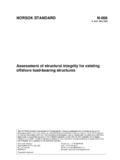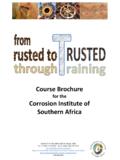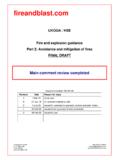Transcription of Key Programme 4 (KP4) - Health and Safety Executive
1 Page 1 of 47 Health and Safety ExecutiveHealth and Safety ExecutiveKey Programme 4 (KP4)Ageing and life extension programmeA report by the Energy Division of HSE s Hazardous Installations DirectorateKey Programme 4 (KP4) Page 2 of 47 Health and Safety ExecutiveContentsPreface 4 Glossary 5 Executive summary 7KP4 findings 8KP4 recommendations 10 Introduction 12 Topic findings 15 Safety management systems 15 Structural integrity 17 Process integrity 18 Fire and explosion 20 Mechanical integrity 21 Electrical, control and instrumentation 22 Marine integrity 24 Pipelines 25 Corrosion 26 Human factors 27 Discussion 28 Leadership 28 Industry readiness for ALE 29 Asset integrity management 29 Obsolescence management 30 ALE audit and review 31 Key performance indicators 31 Data management and trending 32 ALE guidance 32 Skills, training and competence 33 Workforce involvement 34 Decommissioning 34 Recommendations 35 ALE guidance 35 Obsolescence 35 Information management 35 Key Programme 4 (KP4)
2 Page 3 of 47 Health and Safety ExecutivePreparation for life extension 35 Workforce involvement and training 35 For industry 36 For HSE 36 Appendix: Case studies 37 Case Study 1: Structural integrity 37 Case Study 2: Process Safety 39 Case Study 3: integrity management 41 Case Study 4: Electrical, control and instrumentation 43 Case Study 5: Hydrocarbon leak reduction 45 Further information 47 Key Programme 4 (KP4) Page 4 of 47 Health and Safety ExecutivePrefaceThis report communicates the results and recommendations of the Ageing and Life Extension Key Programme (KP4) carried out between 2011 and 2013 by the Health and Safety Executive s Energy report is available on HSE s Offshore Oil and Gas website at Programme 4 (KP4) Page 5 of 47 Health and Safety ExecutiveGlossaryAIM asset integrity managementALARP as low as reasonably practicableALE ageing and life extensionCOMAH Control of Major Accident HazardsCoP cessation of productionDECC Department of Energy and Climate ChangeEC&I electrical, control and instrumentationESDV emergency shutdown valveED Energy Division FPI floating production installationsHCR hydrocarbon releaseHP/LP high pressure/low pressureHSE Health and Safety ExecutiveHVAC heating, ventilation and air conditioningISO International Standards OrganizationKP4 Key Programme 4 KPI key performance indicatorMODU mobile offshore drilling unitOEM original equipment manufacturerOGRE oil and gas release eliminationOGUK Oil & Gas UKORA operational risk assessmentPMR planned maintenance routineKey Programme 4 (KP4)
3 Page 6 of 47 Health and Safety ExecutiveRACI responsibility, accountability, consultation and informationRIDDOR Reporting of Injuries Diseases and Dangerous Occurrences RegulationsSCE Safety -critical element (as defined in the Offshore Installations ( Safety Case) Regulations 2005)SMS Safety management systemSRE Safety -related equipment (equipment supporting SCEs)TR temporary refuge UKCS United Kingdom Continental ShelfKey Programme 4 (KP4) Page 7 of 47 Health and Safety ExecutiveThis is a report of the inspection findings of the Health and Safety Executive s (HSE s) Energy Division s (ED s) Key Programme 4 (KP4) covering the ageing and life extension (ALE) challenges facing hydrocarbon exploration and production installations on the UK s Continental Shelf (UKCS). The Programme investigated the impact of ALE on the risk of major accidents involving the death or serious personal injury to people on an offshore UKCS is a mature oil and gas producing province, with about half the fixed platforms approaching or exceeding their originally anticipated field life.
4 There are potentially significant future challenges to be met associated with the prospect of some installations operating beyond their original cessation of production date, plus the likelihood of a further five years for of ageing requires a good understanding of the condition of Safety -critical elements (SCEs), how that condition is changing over time, and carrying out maintenance in a timely manner to minimise risk of major accidents. There is evidence that installation age is not necessarily a reliable indicator of condition or likelihood of hydrocarbon leak of life extension requires the advanced, and continuing, assessment of SCEs to ensure they are fit for purpose, and safe to use when required to operate longer than their anticipated service, with particular consideration for primary s KP4 Ageing and Life Extension (ALE) Programme was initiated in 2010 and followed the KP3 Asset integrity Management (AIM) Programme which reported in 2007 ( ).
5 KP4 was a forward-looking Programme of work. Its purpose was to: raise awareness of ALE in the offshore industry of the need for specific consideration of ageing issues as a distinct activity within the AIM process; undertake a Programme of inspections of dutyholder approaches to ALE management; identify areas for the improvement of ALE management; encourage the development and sharing of good KP4, HSE undertook 33 onshore and offshore inspections covering all major dutyholders using structured templates across 10 topics: Safety management systems; Structural integrity ; Process integrity ; Fire and explosion; Mechanical integrity ; Electrical, control and instrumentation; Executive summaryKey Programme 4 (KP4) Page 8 of 47 Health and Safety Executive Marine integrity ; Pipelines; Corrosion; Human engaged with industry using several approaches: developing an HSE website portal for disseminating information ( ); encouraging workforce involvement through Step Change in Safety ( ); promoting ALE understanding with workers on their installations; initiating the development of guidance through Oil & Gas UK (OGUK) ( ); raising the profile of ALE by presenting at technical seminars and has welcomed and responded positively to the KP4 initiative, with HSE acting as a catalyst for improvements on the UKCS and worldwide through its KP4 website ( ).
6 There is good evidence that industry leaders have recognised the importance of ALE, but there is much to do to ensure arrangements are implemented in practice, and there is no room for findingsThe KP4 Programme found a range of areas where ALE management was developing well, and areas where extra focus is required. From the Programme , a number of illustrative case studies were developed by dutyholders to elaborate good practices, which can be found in the findings of KP4 were broken down into a series of strategic issues identified below:Leadership and preparedness for ALE Dutyholders response to KP4 was very positive. No mature ALE policies and procedures; however, dutyholders were in the process of developing and integrating them into their AIM systems. Early uncertainties over distinctions between ALE and AIM were soon resolved. Good corporate AIM processes and procedures, although the observed physical condition of offshore assets combined with very large backlogs suggests problems implementing them.
7 Leaders were developing plans for the long-term consideration of AIM, including inserting ALE management into procedures. Occasional insufficient clarity of responsibilities for Safety -related equipment (SRE). Insufficient plans in place to manage the consequences of creeping changes ( normalisation of deviance ). Dutyholders are developing plans to link ALE management to decommissioning. Creation of life of field manager positions to assist ALE management. Dutyholders expressed concerns over the availability of skilled personnel in the industry now and for the future. Expenditure on the UKCS in 2013 was the highest ever ( ) indicating positive leadership for offshore assets for the future, and reinforcing the need for sound ALE Programme 4 (KP4) Page 9 of 47 Health and Safety ExecutiveAsset integrity management Industry feedback was that KP4 had a positive impact on approaches to asset integrity .
8 ALE concepts were becoming embedded into AIM programmes. There was no evidence to suggest that the derogation given to floating production installations (FPIs) to stay on station adversely affects dutyholders ability to determine the asset s integrity . There were significant plans in place by dutyholders to manage fabric maintenance and external condition of hydrocarbon process equipment, with walk-to-work vessels being brought alongside installations to accommodate extra workers to manage the backlog. Some SCE and SRE lists, and engineering drawings, needed updating. Some redundant equipment was not identifiable on site or on drawings. Some primary structural analyses needed updating. More focus is needed on forecasting potential long-term future failure mechanisms. Not enough ALE consideration at the component level. There is industry awareness of the need to address the potential risks associated with difficult to inspect components of primary structures.
9 For rotating equipment, there was a reliance on historical performance from original equipment manufacturers (OEMs), but a need for more forward-looking risk-based assessments to revise planned maintenance routines (PMRs) and so improve Safety and integrity Obsolescence is an area of concern, particularly for electrical, control and instrumentation (EC&I), and to a lesser extent for mechanical equipment. Evidence of missing data, and insufficient data trending this should be improved to help anticipate potential future failures of SCEs, EC&I degradation and obsolescence management. Dutyholders and suppliers are working together to anticipate obsolescence and manage the long-term and KPIs Insufficient leading ALE key performance indicators (KPIs), which could be used to help forecast potential future problems. Dutyholders were commencing targeted audits on ALE management.
10 Developing understanding of the beneficial influence of maintenance management programmes on equipment failure frequencies within an installation s life cycle. Approaches to audits were generally to follow what had gone before, rather than addressing what is needed in the management Insufficient use of data trending to enable forecasting of when equipment is likely to fail its criteria of non-conformance. Insufficient use of data and information, which could lead to a better understanding of the consequences of creeping of ALE guidance The offshore industry recognises the importance of managing ALE better, and engaged well with HSE s Programme 4 (KP4) Page 10 of 47 Health and Safety Executive New approaches to asset integrity and obsolescence management were being developed. OGUK published management systems guidance in 2012, and both OGUK and the Energy Institute will publish further ALE guidance in recommendationsThe offshore industry is expending significant time, effort and money on offshore asset integrity management, and has responded well to KP4.















